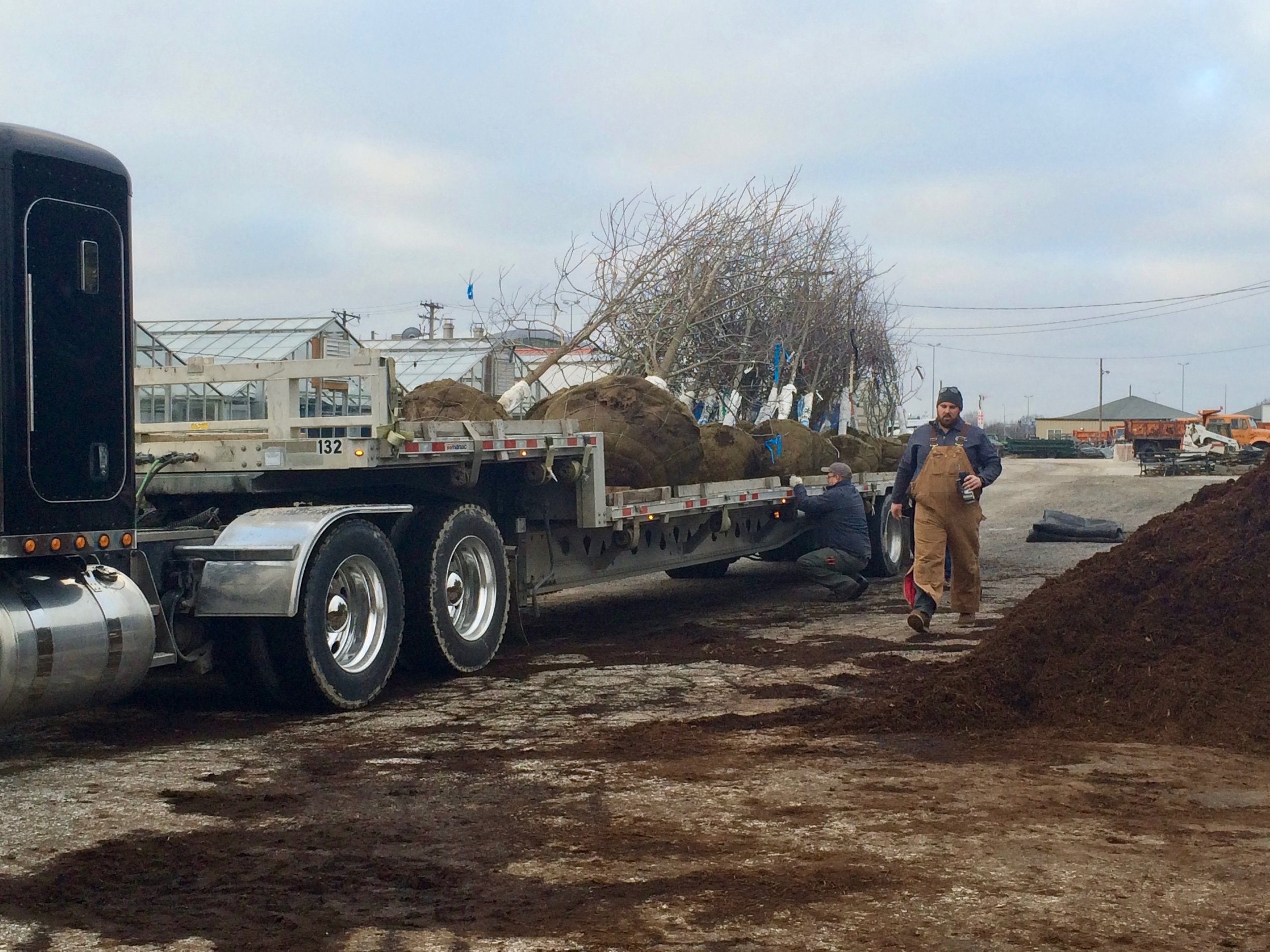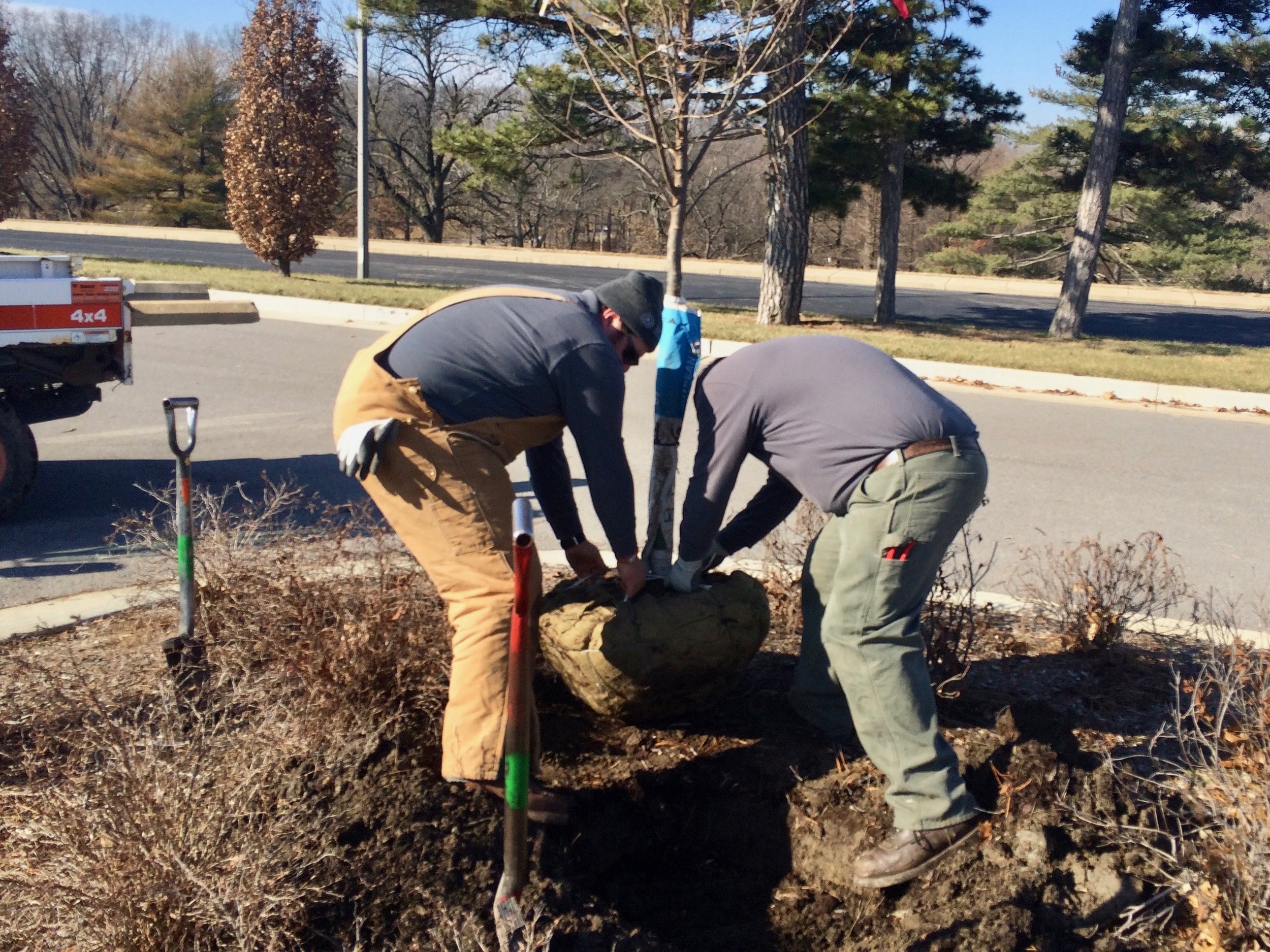Trees Company: A Winter Morning Planting with the FPF Crew
Days in January, despite their frigid temperatures and overcast gloom, are known to be the best for planting trees. The ground is cold, but the new plants incur less shock if they go in when they are dormant as long as the soil isn’t frozen. And while the horticulturists who spend hours hauling, digging, planting and mulching the trees may curse the cold, they’re willing to do it for the long-term impact it will have on Forest Park.
On a fairly mild morning in mid-January, with the aid of a Bobcat, and then a forklift, a Forest Park Forever crew unloaded a flatbed truck holding nearly 30 trees they had chosen carefully from Pea Ridge Forest in Hermann, Missouri. They were spaded up from the land, balled and burlapped, then reinforced with wire before being loaded and delivered. The largest ones in the delivery — three persimmon trees — weighed one ton each.
This somewhat unwieldy delivery was full of tree cultivars that were selected for one or more outstanding characteristics and will go into higher profile places in the park, like near the Emerson Grand Basin, near Steinberg Skating Rink and along main avenues and entrances. Among them were hedge maples, persimmon, American hornbeams, crab apples, serviceberries, gingkos, and Kousa dogwood — each one designated to serve a specific purpose, be it purely ornamental or practical, like providing shade or a bit of biodiversity. The horticulturists estimate they install anywhere from 250–350 trees a year, planting 10 a day in a particular area if it’s a good day and they have the available staff.
For horticultural care purposes, Forest Park is split up into seven zones, each managed by a horticulturist. The shipment from Pea Ridge was split up per their needs for replacements of dead trees or additions to the landscape whose design is dictated by the Park’s Master Plan. The horticulturists do have the freedom to make changes based ever-changing factors like foot traffic, the elements, disease resistance, etc., but much of it is predetermined, making it almost like a paint-by-numbers project.
Chris Kelly (above), who oversees Zone 7 (Park entrances) and gardener Mike Renner went straight to work after unloading the trees, eager to put in a replacement lacebark elm that hadn’t taken hold on a parking island surrounded by shrubs at the Festival & Parking Plaza (the old Upper Muny Lot). That area alone holds roughly 20 species of trees, which is an impressive amount of diversity for a parking lot and festival space. “You normally wouldn’t see an elm in a parking lot,” said Chris, “but this isn’t the parking lot at a big box store — this is Forest Park.”
Chris and Mike dug a wide hole, about a foot deep, pulling out any residual roots before cutting the reinforcement wire, slitting the burlap, then dragging the tree into its spot. They made sure its trunk stood straight, as any wind in the lofty lot could easily topple an unrooted and crooked tree on its side. They put every speck of original soil over the roots, making sure to protect the root flare, which is the most vulnerable part of a new tree.
“A lot of times I see kids climbing a tree or touching it and I get overprotective,” says Kelly. “But people experience nature by doing more than just looking at it.”
“I have a tendency — when I’ve put this much effort toward something — to be protective," he says. "But you have to step away and say, ‘This is what this tree is here for—for people to enjoy.’”
Tips I Picked Up:
- Don’t put fruit-bearing (aka, shedding) trees such as crabapples and gingkos along paths.
- Water regularly. Mulch once or twice a year. And prune after the first year planted.
- Staking a tree can eventually make it weaker, as it acts like a crutch the tree relies on and never fully establishes its roots. Exposing it to wind can actually increase its girth and ability to become a hearty plant.
- Consider size, shape, and species when choosing a tree. Make sure there is enough diversity in the selection to eliminate susceptibility, so a bout of disease or infestation won’t take out the whole lot.






